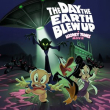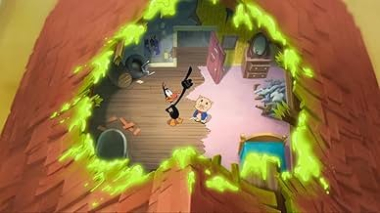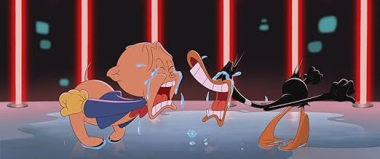
The Day the Earth Blew Up Review
I recently experienced a film that completely reshaped my perspective on spectacular sci‑fi disasters. From the moment I sat down in a darkened theater, my senses were set ablaze by a tapestry of visuals and emotions. The movie, The Day the Earth Blew Up, took me on a whirlwind journey where humor, terror, and heartfelt emotion intertwined in ways I never anticipated. Watching this film in first person, I felt as though I was part of the unfolding events, immersed in an experience that was both exhilarating and thought provoking.
An Arrival into Chaos
The opening sequence of the movie hit me like a sudden jolt. The atmospheric arrival of cataclysmic events was masterfully presented using a blend of vibrant imagery and unsettling soundscapes. I found myself sitting in awe as the film introduced an extraordinary scenario: an entire planet caught in the grip of forces beyond comprehension. The imaginative narrative immediately captured my attention through its unusual rendering of everyday existence intermingled with extraordinary cosmic events. Every visual element and narrative twist seemed to whisper that nothing in this universe would remain ordinary for a single moment.
The Dance of Plot and Narrative
As the storyline developed, I became deeply engaged with the multifaceted narrative arc. The plot was complex yet fluid, moving through a series of unexpected turns that oscillated between surreal comedy and genuine crisis. I marveled at how the film maintained a delicate balance between absolute absurdity and profound introspection. The narrative’s clever interplay of irony and suspense invited me to reflect on the existential nature of our world while simultaneously entertaining me with its ludicrous yet fascinating events. This cinematic dance had me pondering the intricate details of every storyline twist while remaining completely captive to the overall spectacle.
The Heartbeat of Character Journeys
The character dynamics in The Day the Earth Blew Up provided the spiritual core of the film. I connected with the diverse ensemble, each portrayed as an individual grappling with their own sense of destiny amid chaos. The characters were not merely vehicles for advancing the plot but rather avenues for emotional exploration and introspection. Their passions, vulnerabilities, and humorous revelations resonated with me deeply. I experienced a gamut of emotions watching them confront unfathomable scenarios, and their development over the course of the movie was portrayed with an honesty that was both refreshing and challenging. It was a reminder that even against cosmic backdrops, the human condition remains at the forefront of every tale.
A Visual Feast of Cinematic Aesthetics
The art direction and cinematography in this movie were nothing short of a visual feast. Each frame appeared as a meticulously composed painting, blending saturated colors with stark contrasts that underlined the film’s narrative mood. I was impressed by how the lighting accentuated the dramatic tension of the unfolding events. Detailed set designs and otherworldly landscapes were brought to life through creative camera angles and innovative visual effects. The bold use of color and light served not only as an aesthetic choice but also as a narrative device, heightening the tension during critical moments and providing moments of bizarre beauty amidst chaos. The visuals transformed each scene into an immersive space where the extraordinary felt almost palpable.
An Orchestration of Sound and Music
The auditory elements in The Day the Earth Blew Up played an indispensable part in shaping the overall experience. The film’s score was both haunting and invigorating, weaving an aural narrative that complemented the on‑screen spectacle seamlessly. I found myself completely absorbed by a soundscape that married orchestral swells with minimalist electronic effects, drawing me deeper into the film’s dual realms of reality and surreal imagination. Sound and silence alternated in dizzying rhythm, each piece of music accentuating moments of tension or relief. In my personal experience, the blending of sound and cinematography created an emotional resonance that was almost transcendent, reinforcing the film’s thematic undercurrents and intensifying my connection to every unfolding scene.
The Marvel of Special Effects and Practical Ingenuity
Having seen my fair share of awe‑inspiring special effects in science fiction, I still found the technical prowess displayed in this movie utterly impressive. The special effects were not mere embellishments but foundational elements that expanded the narrative. I was particularly captivated by the way practical effects blended with computer‑generated imagery to simulate a universe in relentless transformation. Each explosion, cosmic wave, and shifting landscape exhibited an attention to detail that rendered the impossible believable. The sheer scale of the effects and the ingenuity behind the simulation of catastrophic events had me marveling at the dedication of the production team. The practical techniques used in key sequences evoked a tangible realism, inviting me into a visceral experience where every second pulsed with energy.
The Rhythm and Pacing of a Cosmic Ride
The narrative pacing of The Day the Earth Blew Up felt both unpredictable and meticulously structured. I experienced a rollercoaster of tempo changes as the movie moved from quiet moments of introspection to rapid sequences of chaos and action. The clever pacing allowed for breath‑taking visual moments to shine before plunging back into dynamic story segments. The structure was layered with both suspenseful build‑ups and reflective pauses, which I found deeply engaging. This orchestrated ebb and flow of narrative energy encouraged me to adapt my own emotional rhythm to that of the story, creating an intimate relationship with the pace at which the universe around the characters shifted from frenetic to contemplative.
The Shared Experience with the Audience
One remarkable aspect of the movie was its inherent ability to foster a unique level of audience engagement. In viewing the film, I realized that I was not just a passive observer; instead, I became an active accomplice in the journey the characters embarked upon. The interactive narrative motifs and direct addresses to the audience created moments where I felt personally involved in the unfolding drama. I appreciated how the film subtly acknowledged that its viewers carried their own experiences into its vivid cosmos. This deliberate interactivity resonated with me, as it transformed the movie from a simple visual display into an immersive experience that invited contemplation and personal connection with each twist and turn.
Escaping into Alternate Realms and Themes
The thematic undercurrents in The Day the Earth Blew Up revealed a layered complexity that went far beyond the surface spectacle. As I watched the narrative, I was drawn into underlying questions regarding our place in a vast and indifferent universe. Themes of existential uncertainty and the randomness of fortune wove through each scene, urging me to reflect on the juxtaposition of fragility and resilience inherent in life itself. The film presented these ideas in a manner that was both subtle and bold—melding philosophical inquiry with a narrative that did not shy away from the absurdity of its premise. During moments of quiet solitude amidst the chaos, I found myself contemplating the delicate balance of our existence, realizing that even the most catastrophic scenarios can evoke a sense of wonder and reflection on the human spirit.
The Craft of Direction and Script Nuance
The directorial vision behind The Day the Earth Blew Up was evident throughout every frame, and I was left in deep admiration for the creative choices that shaped the film. The direction was imaginative without resorting to cliché, and the script was filled with moments that were both clever and deeply personal. I connected with the narrative voice that seemed to oscillate between a knowing observer and an impassioned storyteller. The dialogue often veered into realms of poetic absurdity, reinforcing the film’s unique tone without losing sight of its narrative integrity. Each scene was a demonstration of careful planning and creative spontaneity, challenging me to view the familiar through an entirely new lens and appreciate the delicate interplay between destiny and chaos portrayed in the story.
The Unusual Blend of Humor and Gravitas
One of the most striking aspects of my viewing experience was the film's masterful blend of humor and gravitas. While the narrative prominently featured cataclysmic events that could easily overwhelm the senses with despair, there was also an undercurrent of humor laced throughout. I found moments of absurd wit that provided relief in the face of inevitable disaster. The light‑heartedly absurd scenarios coexisted harmoniously with instances of serious emotional depth, creating an atmosphere that was both entertaining and intellectually stimulating. This unpredictable mixing of tones kept me engaged on multiple levels, allowing me to laugh at the surreal predicament while simultaneously being drawn into the poignant emotional struggles of the characters.
The Impact of Genre Innovation on My Perspective
Reflecting on my cinematic journey after watching The Day the Earth Blew Up, I realized how powerfully it reshaped my understanding of sci‑fi conventions. The movie managed to break free from the constraints of traditional narratives, offering an innovative and refreshing approach to a genre that sometimes feels formulaic. I appreciated the film's fearless exploration of science fiction tropes, transforming a potentially overused idea into a vibrant new narrative. The unconventional storytelling techniques challenged my expectations and encouraged me to embrace a more nuanced view of what a cataclysmic event in space might signify. This film not only entertained me but also expanded my horizons, leaving a lasting impression on the way I perceive cosmic narratives and their deeper implications.
Cultural Resonance and the Legacy of Absurdity
What struck me most in this cinematic experience was the manner in which the movie resonated with cultural motifs of the modern era. In watching the film, I was continually drawn to thematic elements that reflected our contemporary struggles, be they existential doubts, societal disruptions, or the surreal challenges of modern life. I found that the satirical undertones of the film mirrored the contradictions of today’s world—rapid technological advancement juxtaposed with human vulnerability, epic narratives interwoven with personal stories. This cultural interplay created a context that was both familiar and jarringly unconventional, ultimately inviting me to reconsider the status quo of how disaster and absurdity can coexist harmoniously in the art of storytelling.



